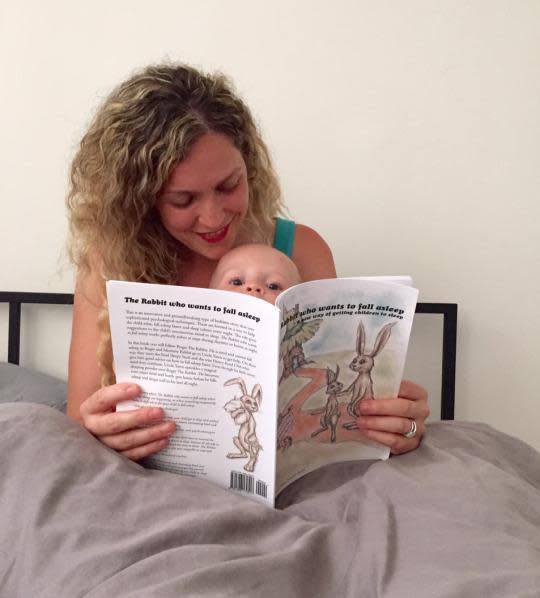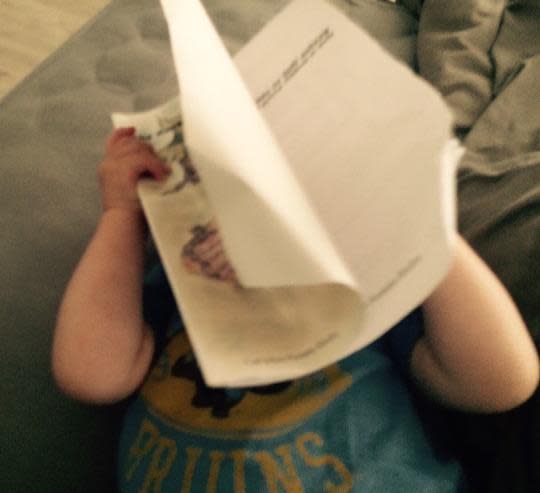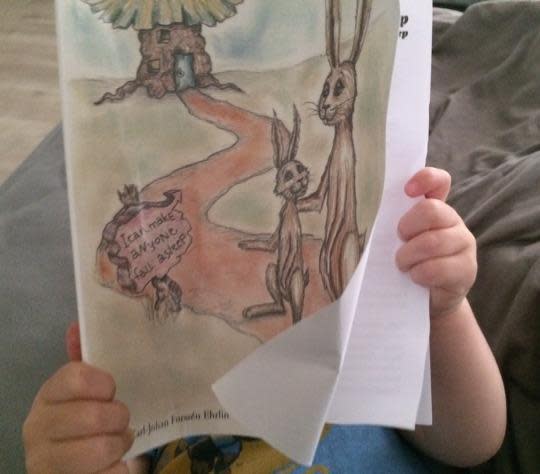The Book that Promises to Put Babies to Sleep Fast, Put to the Test

The Rabbit Who Wants to Fall Asleep promises to make your kid fall asleep fast. Will it work on my active toddler? (Photo: Elise Sole)
Sleep is a big deal in my home. As a mom who works full time — with a husband who burns the night shift and a 13-month-old who’s not sleep trained — I was psyched to hear about the buzzy, bestselling book that promises to put a child to sleep in minutes. While my son sleeps through the night with no difficulty, the process of getting him down can be challenging.
STORY: Bestselling Book Promises Kids Will Fall Asleep at Bedtime
The Rabbit Who Wants to Fall Asleep has been hailed as a bedtime staple, a sanity saver, and in some cases, a cautionary tale, which, read in the wrong environment, can pose safety hazards. Although published in 2014, it recently shot to the top of the Amazon bestseller list, surpassing Harper Lee’s Go Set a Watchman and Paula Hawkins’s The Girl on the Train. It only has 72 Amazon reviews, but it’s rated 4.5 stars and is described by parents as “fantastic,” “highly recommended,” and “amazing.”
The 26-page book follows a rabbit named Roger who can’t sleep because all he can think about is playing outside. Desperate for some shuteye, Roger and Mommy Rabbit embark on a journey to visit Uncle Yawn. Along the way, they meet Heavy-Eyed Owl and Sleepy Snail, who discloses the secrets to relaxing before bed. Roger and his mother finally reach Uncle Yawn’s treehouse, where he casts a spell on Roger and sprinkles him with invisible sleeping powder (specified only to work on children and rabbits) and sends Roger home.
STORY: Dad’s Trick Gets Baby to Sleep in Just 40 Seconds
The book is written by a Swedish psychologist named Carl-Johan Forssén Ehrlin, who claims to use a series of “powerful psychological techniques” to encourage drowsiness. Certain text is bolded, which the reader is to emphasize, and italics indicate enunciation. The reader and child are also supposed to yawn at promoted points in the story and the child’s name can be subbed into indicated brackets.

The Rabbit Who Wants to Fall Asleep was a bedtime story fail — at least in my home. (Photo: Elise Sole)
I was skeptical about trying this book on my son, given his short attention span. I’ve been reading to him daily since he was a newborn, but once he passed the 6-month mark, he began regarding books as edible objects and I began paying our local library damaged item fees. Still, curious about a tool that might speed up our bedtime ritual, I decided to give it a go. My kid is too young to understand the meaning of the words, but the book has no age requirements: “Roger the Rabbit was just your age. Not older, not younger, exactly as old as you are [name].”
For a bedtime story, The Rabbit Who Wants to Fall Asleep is long — 26 pages — and parents are encouraged to read the entire book, even if the child has fallen asleep. But I knew my bouncy son couldn’t sit still for that long.
I also suspected the process might be challenging — that day, my son skipped his morning nap due to a family day trip. And although he slept 30 minutes in the car, he was overtired and excitable in the evening — just like Roger the Rabbit, I figured. After his bath, I got him into his pajamas and we climbed into bed.

Story time isn’t for every kid. (Photo: Elise Sole)
Story time isn’t a part of our bedtime routine, so upon seeing the paperback, my son pounced. Gently pulling it away, I adopted the soothing tone of voice recommended in the book and said, “Now, we’re going to read a story.” But like any other toddler denied what he wants, he shrieked and lunged for the book again, pawing at it and ripping the cover.
“OK, OK, OK. Let’s read together,” I compromised, ignoring the book’s clear instructions to have the child lie down and not look at the illustrations, which are deemed distracting. Sitting him in my lap, I displayed the book in front of us and started to read, but he pulled it down and began flipping through the pages. Ordinarily, I encourage interactive reading, but on that night, I had a mission.
Unfortunately, the book wound up anything but read — it ended up on his face, on the floor, and at one point, almost ripped in two, as he curiously wrestled with his newfound object. We didn’t get past the first several lines of the book, and I quickly abandoned the idea, resorting to our usual go-to-sleep method, which includes a series of songs and quiet games.
Did I do anything wrong? Or is the book hit or miss? “You didn’t do anything wrong,” Deborah Gilboa, MD, a parenting expert and family physician, tells Yahoo Parenting. “It’s normal for a 13-month-old child to be more curious about how a book tastes than the story itself. Especially a book that instructs the reader to avoid looking at the pictures.”
And while a child who isn’t sleep trained is the perfect candidate for a book that promises fast sleep, it’s possible that it would work better during a different developmental stage. “A child between the ages of 9 months and 24 months, who has mobility but not enough language skills, might actively engage with a book instead of listening to it,” she says.
Bedtime stories aren’t routine in every home. In fact, only 33 percent of parents read to their children at night, according to a study conducted by Harris Interactive. And while there are benefits — “reading is a good sedentary activity that promotes cuddling and relaxing brain chemicals,” says Gilboa — they’re not a requirement for healthy sleep.
The book was also a commitment for me. Once my baby falls asleep, my bedtime ritual includes tiptoeing out of the room for a glass of wine. “What parent wants to read aloud a 26-page book after their kid falls asleep?” says Gilboa. Thank you.
I’m not disparaging the book — if your kid has trouble sleeping and it works, then you’re in luck. But I’ll stick to my own routine.
Please follow @YahooParenting on Facebook, Twitter, Instagram, and Pinterest. Have an interesting story to share about your family? Email us at YParenting (at) Yahoo.com.

